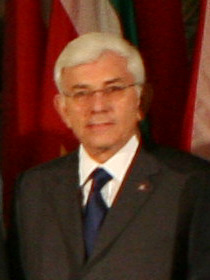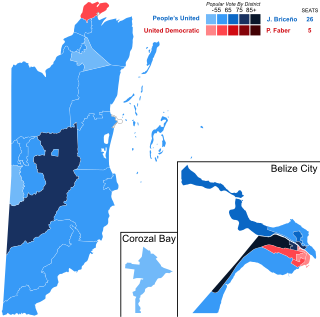
A national flag is a flag that represents and symbolizes a given nation. It is flown by the government of that nation, but can also be flown by its citizens. A national flag is typically designed with specific meanings for its colours and symbols, which may also be used separately from the flag as a symbol of the nation. The design of a national flag is sometimes altered after the occurrence of important historical events. The burning or destruction of a national flag is a greatly symbolic act.

The national flag of Poland consists of two horizontal stripes of equal width, the upper one white and the lower one red. The two colours are defined in the Polish constitution as the national colours. A variant of the flag with the national coat of arms in the middle of the white fess is legally reserved for official use abroad and at sea. A similar flag with the addition of a white eagle is used as the naval ensign of Poland.

Said Wilbert Musa is a Belizean lawyer and politician. He was the third prime minister of Belize from 28 August 1998 to 8 February 2008.

George Cadle Price was a Belizean statesman who served as the head of government of Belize from 1961 to 1984 and 1989 to 1993. He was the first minister and premier under British rule until independence in 1981 and was the nation's first prime minister after independence that year. He is considered one of the principal architects of Belizean independence. Today he is referred to by many as the "Father of the Nation". Price effectively dominated Belizean politics from the early 1960s until his 1996 retirement from party leadership, having been the nation's head of government under various titles for most of that period.

The People's United Party is one of two major political parties in Belize. It is currently the governing party of Belize after success in the 2020 Belizean general election, winning a majority of 26 seats out of 31 in the Belizean House of Representatives. It is a centre-left Christian democratic party. The party leader is Johnny Briceño, who currently serves as the Prime Minister of Belize.

The United Democratic Party is one of the two major political parties in Belize. It is currently the main opposition party, having lost the 2020 Belizean general election, after previously holding the government across three prior terms. Founded as a centre-right conservative party, the UDP is led by Moses Barrow.

Sir Manuel Amadeo Esquivel was a Belizean politician. As leader of the United Democratic Party, he served as the second prime minister of Belize from 1984 to 1989, and then again from 1993 to 1998. His party's victory in 1984 was the first time an opposition party had won a general election in Belize.

The coat of arms of Belize was adopted upon independence, and the current coat of arms is only slightly different from that used when Belize was a British colony.

The national flag of Colombia symbolizes that Colombia gained its independence from Spain on 20 July 1810. It is a horizontal tricolor of yellow, blue and red. The yellow stripe takes up a half of the flag and the blue and red take up a quarter of the space each.

The national flag of Spain, as it is defined in the Constitution of 1978, consists of three horizontal stripes: red, yellow and red, the yellow stripe being twice the height of each red stripe. Traditionally, the middle stripe was defined by the more archaic term of gualda, and hence the popular name la Rojigualda (red-weld).

The flag of Uganda was adopted on 9 October 1962, the date that Uganda became independent from the British Empire. It consists of six equal horizontal bands of black (top), yellow, red, black, yellow, and red (bottom); a white disc is superimposed at the centre and depicts the national symbol, a grey crowned crane, facing the hoist's side.

The flag of The Gambia is the national flag of The Gambia. It consists of three horizontal red, blue and green bands separated by two thin white lines. Adopted in 1965 to replace the British Blue Ensign defaced with the arms of the Gambia Colony and Protectorate, it has been the flag of the Republic of the Gambia since the country gained independence that year. It remained unchanged throughout the Gambia's seven-year confederation with Senegal.

General elections were held in Belize on 30 June 1993. Although the People's United Party received the most votes, the United Democratic Party–National Alliance for Belizean Rights alliance won the most seats. Voter turnout was 72.1%.
United Black Association for Development (UBAD) was a cultural and political party established in Belize in February 1969 and based on traditional Black Power tenets.

General elections were held in British Honduras on 1 March 1965. Belizeans elected 18 members to the British Honduras Legislative Assembly.

Philip Stanley Wilberforce Goldson was a Belizean newspaper editor, activist and politician. He served in the House of Representatives of Belize as member for the Albert constituency from 1965 to 1998 and twice as a minister. Goldson was a founding member of both of Belize's current major political parties, the People's United Party (PUP) in the 1950s and the United Democratic Party (UDP) in the 1970s. He was also the leading spokesman of the hardline anti-Guatemalan territorial claims National Alliance for Belizean Rights party in the 1990s.
Leigh Richardson was a Honduran-born Belizean politician. Richardson served as the leader of the People's United Party in the 1950s, and also as mayor of Belize City.

General elections were held in Belize on 11 November 2020 to elect the 31 members of the House of Representatives. Nomination day was 21 October.



























